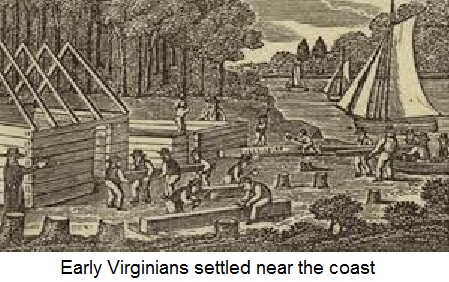William Haynes (1710-1781) and Elizabeth Milner Haynes (1710-1780)

Virginia, for its first hundred years, was settled only along its coast. Those early settlers struggled to survive and depended heavily on ships from England. With time, though, they learned how to live off the land, how to farm and make essential goods. There were vast amounts of fertile land available inland and so some began to move westward, away from the sea.
Those new migrants cherished independence and self-sufficiency. They sought the chance to better their circumstances, to raise and feed families and to run their lives on their own terms. They were the original American pioneers. Their love of opportunity and self-sufficiency helped give birth to a new nation, to shape its personality and its path through history.
Among those early Virginia pioneers were Elizabeth and William Haynes, two of your ancestors. Soon after their marriage they began a series of westward moves, finally settling 200 miles inland in a forested area (Bedford County) that was deep inside Indian-held territory. They and their few neighbors did everything from clearing land to delivering babies to making soap to setting broken bones to making clothes. They farmed, raised animals, hunted, gathered fruit and did whatever else it took to survive.
William and Elizabeth had married at 24. By age 44 they’d had at least eight children, including your grandfather Henry Haynes. The total number of children born might have been higher than eight as the eight names that are known were the ones who made it to adulthood. Infant and chideaths were common in those times.

Indian raids were also common on the early Virginia frontier. William served as a local militiaman for about 20 years, occasionally fighting off Indian raids. Some of William and Elizabeth’s neighbors died in the raids, as did Indians.
Their farm was about 400 acres which was a modest size considering the era’s poor crop yields. It likely provided only a subsistence living. The main food crop was corn, supplemented with sorghum (molasses) and vegetables. The cotton for clothes was produced locally. Hunting plus a few cattle and hogs provided meat.

William and Elizabeth supported the American Revolution. William was an officer in the Continental Army though, given his age (65), he probably was not a front-line fighter. William and his son Henry (your ancestor) provided beef to the struggling Continental Army. They were committed.
Elizabeth’s and William’s lives on the Virginia frontier took great willpower. Neighbors and church provided moral and limited material support for each other in times of crisis but their resources were meager. It took resourcefulness and determination and n ability to shrug off discouragement. The pioneers as a group were tough folk.
One final note on William Haynes – his last will and testament. He had his will prepared at age 70 – perhaps he was sick, perhaps he simply believed in preparation. My guess is that he was sick, as he died later that year. He could not read or write and so his signature was simply a “W”.
The usual practice in this 1700s was to have a son as executor (an executor is the person in charge of the will) and to leave the bulk of his property to his oldest son. Oldest sons were important in those days. William Haynes broke those traditions in many ways.
First, he named his two sons-in-law, not his sons, as co-executors of the will. That was highly unusual. Second, he gave the farm and the bulk of his meager possessions to one son-in-law, not to his biological children. Had there been a family fight that strained William’s relationships with some of his children?
Perhaps geography played a role (several sons had moved westward) or maybe there were bad feelings in the family, or maybe the motives were neither of those reasons. We’ll never know.
As a writeup (linked below) on William Haynes notes, even if he left his children no possessions, he did leave to them the pioneer spirit and the ability to live on the frontier, which they did. We can be grateful to him for that.

Further reading:
Haynes Website













